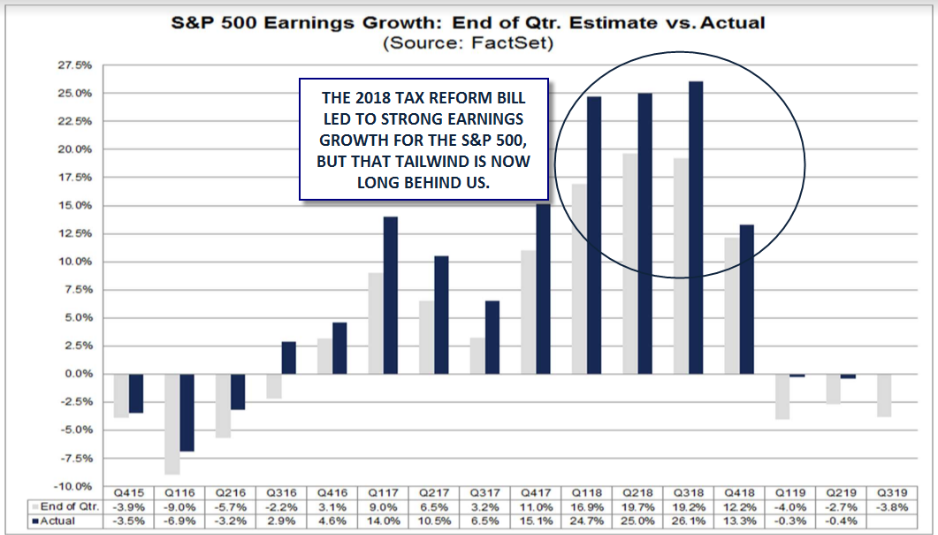After a run of weak US economic data over the last week, traders are wondering whether we’re in a “bad-news-is-bad-news” environment (where concerns about weak economic growth lead to a selloff in risk assets like stocks) or a “bad-news-is-good-news” regime (where signs of a slowing economy actually boost stocks by increasing the likelihood that the Federal Reserve lowers interest rates).
Regardless of what happens in the short term, the long-term driver of stock-market returns will always be earnings – and heading into the Q3 reporting season, earnings expectations are downbeat. According to the earnings mavens at FactSet, S&P 500 earnings are expected to decline by -4.1% year-over-year, with particularly downbeat expectations in the Energy and Materials sectors. If earnings for the S&P 500 do in fact decline this quarter, it would mark the third consecutive quarterly decline, the first such streak since mid-2016:

Source: FactSet, FOREX.com
In addition to monitoring how Q3 earnings and revenue figures print relative to expectations, forward-looking traders should also keep a close eye on companies’ earnings guidance for the next quarter. As we learned over the last quarter, a company’s outlook for the future is often a more important driver for stock prices than past earnings and revenue figures, especially with the ongoing US-China trade tensions disrupting many international firms’ operations.
From a fundamental perspective, there are a couple of signs that stocks may be particularly vulnerable on weak earnings reports this quarter. Most straightforwardly, the forward P/E ratio for the S&P 500 is 16.5, above the 10-year average of 14.8; stocks in the Consumer Discretionary space may be particularly vulnerable given the sector’s 20.7 P/E ratio, while Financial stocks may be more insulated with an average P/E ratio of just 11.7.
Digging a bit deeper, the year-to-date performance of the various sectors is also waving a yellow flag for bulls. For the uninitiated, sector rotation is the subset of technical analysis that involves evaluating what types of stocks are performing well to help predict how the stock market as a whole will perform moving forward. Historically, economically sensitive sectors such as technology, material and energy stocks tend to outperform the stock market in a healthy uptrend, while economically insensitive sectors like utilities and health-care stocks typically outperform when the market is at risk of a pullback. As the chart of YTD relative performance against the S&P 500 index shows, more conservative sectors (REITs, Utilities and Staples) are outperforming, while some of the pro-cyclical sectors (Financials, Materials and Energy) are underperforming the broader index:

Source: FOREX.com, StockCharts.com
Between the US-China trade war, ongoing political uncertainty, tensions in the Middle East and risks of a possible no-deal Brexit, there are plenty of potential stumbling blocks for S&P 500 companies to navigate this earnings season. Index traders should keep a close eye on the performance of big industry bellwethers for insights into the overall economy, while individual stock traders may want to focus their attention on companies with greater exposure to the domestic economy, which is still holding up better than the rest of the world, despite the recent run of weak data.
